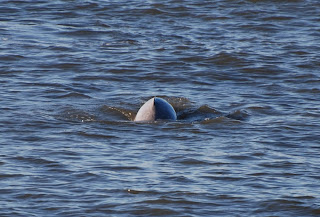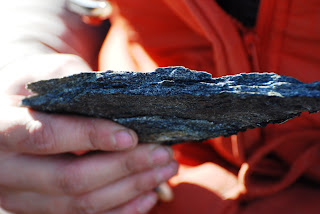Alaskan native tradition says the valley of Serpentine Hot Springs is the home of powerful spirits. I could see how those beliefs came about last time I visited in July, but the 3 days I spent there this past weekend were perhaps some of the most beautiful days I have ever been lucky enough to experience.
 |
| Beaver lodge and dam |
It was a short trip this time to assist an NPS biologist in some water quality testing along Hot Springs Creek. Our task for the weekend was to install 3 data loggers in strategic parts of the stream, and assess the impact of the beaver colonies that have taken up residence around the hot springs.
 |
| Bunkhouse |
Due to a combination of our high rainfall this summer and the increased beaver activity, the creek was significantly more flooded than it had been in July, to the point of coming almost all the way up to the bunkhouse. Other things were different too -- unlike the rich green grasses and wildflowers of summer I saw
last time, this time the valley was a vibrant golden spectrum of autumn hues.
 |
| Water droplets cling to grass beside the hot spring |
The overall temperature was quite a bit colder too, hovering between the low-30s to mid-40s. Nonetheless, the hot spring remained at a constant ~150 degrees F, swathing the bunkhouse in a lovely sulfurous cloud of warmth.
We got to work almost as soon as we arrived around mid-day on Friday. Donning 2 layers of pants plus a huge pair of size 12 hip waders and about 4 layers of shirts, I joined the two other women in similar fashion to check the first data logger site near the bunkhouse. Although it wasn't far, it was a slow, laborious hike through extremely dense willows part way, and thigh-deep through a roaring 38-degree river the other part of the way, carrying a heavy pack, some rebar, and a small sledge hammer
.
We spent several hours in the river. We stretched a transect line from one bank to the other and tested water pressure and velocity every 12 inches. The hardest part was probably working in the intense flow of the river; it was strong enough to push my feet along the bottom if I stood still. Nonetheless, I hammered the rebar in and we attached to it a data logger (which, unfortunately had to be done by hand, reaching into said 38-degree water -- think pins and needles all the way up your arm!).
 |
| Biologist feeling the hot spring temperature |
The same day we also hiked to Arctic Hot Springs, another hot spring some ways down from Serpentine. Here we did the same procedure: clamber through willows until we found the right GPS coordinates for where the data logger should be, set the transect, hammer in a rebar, test the water velocity, attach the data logger, try not to freeze to death, and hike back.
 |
| Epic rainbow |
Just as we got back to the bunkhouse at the end of the day, a rainbow started forming over the tors. As we drew closer, it formed into a full-on, all-the-way-across-the-sky rainbow, totally mesmerizing. It was impossible to capture the beauty and all the colors in a photo, but I think I came pretty close. :)
 |
| Fall colors on the tors |
 |
| Bathhouse windows |
To top off the day, I sat for a while with my feet in the hot tub.
 |
| The (somewhat sketchy) bathhouse |
 |
| View of the valley |
The next day was quite busy as well. Same routine, except this time we headed the opposite direction, to go upstream of the beaver activity.
 |
| Testing the water along the transect |
Fortunately, now that we'd had some practice, the procedure went much smoother and the water levels even seemed to be down a little. After spending a little over half the day doing water tests, the interpretive ranger and I spent the rest of the time hiking in the tors and taking photos.
 |
| Bearberry turns BRIGHT red in the fall |
 |
| Northern Harrier |
The only wildlife I saw the entire weekend were some Northern Harriers and Rough-Legged Hawks. However, there was an Alaskan Air pilot staying in the bunkhouse for the weekend to do some hunting, and he reported seeing 3 grizzlies and a herd of caribou while he was out and about.
 |
| Taking a break on the tundra |
 |
| A quiet moment on the tors |
 |
| Bunkhouse and tors |
 |
| Having too much fun :) |
 |
| Snowmachine marker |
There is one recognizable trail in Serpentine, and it's carved out for snowmachines in the winter. Once there's adequate snow cover, villagers will come from 50-100 miles away to visit the hot springs. I can't imagine what that must be like!
 |
| Pretty incredible picture by Ranger Katie |
After another long day I took a full soak in the hot tub, watching the sun set through the windows. As it got lower in the sky, at one point it sent shafts of brilliant golden light came through the chinks in the walls, shining through the steam across the water. I wish I'd had my camera, but in some ways it was more special just to experience it alone without trying to capture the moment.
The next morning we had to get up somewhat early to call our pilot. When the biologist came back inside from talking on the satellite phone, she announced "It snowed last night!"
 |
| Fresh fall snow |
I threw on a few layers of clothes, grabbed my camera, and ran outside. The sun was just about to rise, and all around from the distant tors to the Continental Divide, a fresh dusting of snow blanketed the landscape.
 |
| Snow on the Continental Divide |
It was one of the most beautiful things I've ever seen: The fall colors with a backdrop of pure white and a pink sky with clouds beginning to part for the sun.
 |
| Fiery sunrise |
 |
| Snow falling in the distance |
It was such a quiet morning too. No roaring tundra wind like usual. Just the gentle sound of the creek, and the crunch of ice under my boots as I hiked to the top of the hill. I found a spot on top of a tor and sat down to watch.
 |
| Sunrise over the bunkhouse |
 |
| Sunbeam |
As I sat there on that rock with no one else in sight, watching the sky change colors of pink and orange over that awe-inspiring landscape, snow began to fall gently all around me. At first I thought it was rain but then I realized they were bunches of snowflakes sticking to my hair and boots and clothes.
Before I knew it, snow flurries were coming down and dancing in the pink sunlight, a symphony of colors and light choreographed to an orchestra of wilderness. It was the most beautiful thing the world.
 |
| Snow falling |
Eventually I hiked back to the bunkhouse for breakfast and to help finish with the last of the water quality testing. All morning, snow fell in little flurries.
We were still out in the field heading back from our last stream sample site when we heard the bush plane coming to pick us up. We hurried back to the bunkhouse (as fast as one can hurry in gigantic hip waders), changed into our flight gear, loaded the plane, and just like that, our time in Serpentine came to an end.
It was a short excursion, but packed with so many new experiences it was the trip of a lifetime. It's days like these that make me so glad I chose the life path that I have, and so fortunate to have the opportunities that I've had.






























































